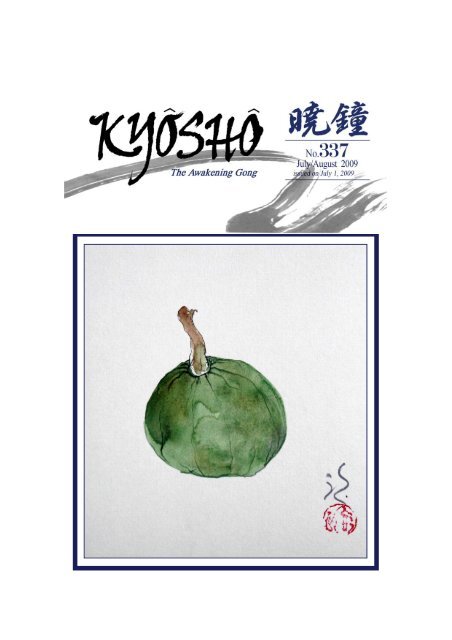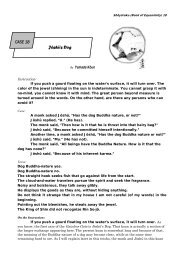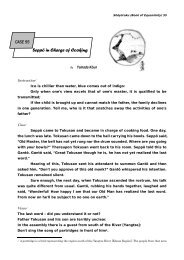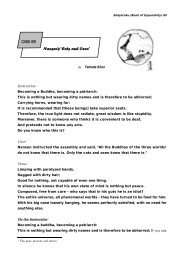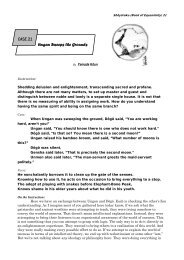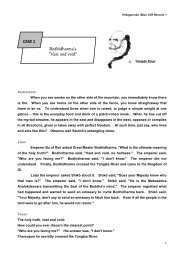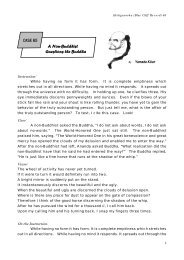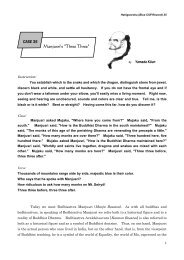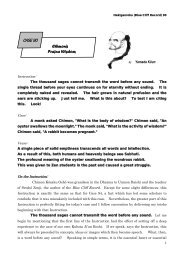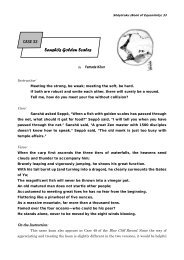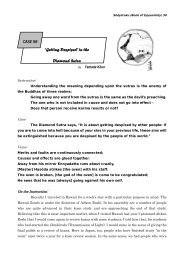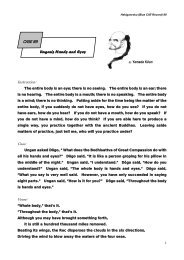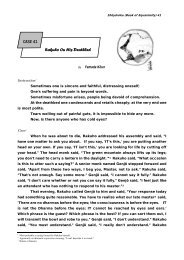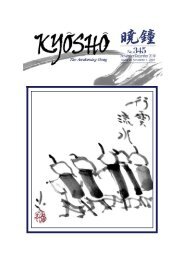Create successful ePaper yourself
Turn your PDF publications into a flip-book with our unique Google optimized e-Paper software.
―<br />
……………………………………………………<br />
To learn the Buddha Way<br />
is to learn one’s own self.<br />
To learn one’s own self<br />
is to forget one’s own self.<br />
To forget one’s own self<br />
is to be enlightened<br />
by the myriad dharmas.<br />
To be enlightened<br />
by the myriad dharmas<br />
is to let one’s own mind and body<br />
as well as that of all others<br />
fall off.<br />
( from: Chapter “Genjô-kôan” in the Shôbôgenzô by Master Dôgen )<br />
……………………………………………………
Contents<br />
Photo by SATO Migaku<br />
Opening Comments :<br />
Report on the Sesshin in San Francisco……… by YAMADA Ryôun 0 4<br />
Teisho: Hekiganroku (Blue Cliff Record) Case 97 ……by YAMADA Kôun 007<br />
Teisho: Shoyoroku (Book of Equanimity) Case 15…… by YAMADA Ryôun 14<br />
In Memoriam P. LENGSFELD …………………………… by Lore MOLLY 20<br />
In Memoriam P. LENGSFELD (Deutsch)…………………by Lore MOLLY 22<br />
Remembering Ms. YOSHII Tsue<br />
In Memory of Ms. YOSHII Tsue, Our Tenzo…by TONOIKE Toshio 23<br />
The Big Sister of <strong>San'un</strong> <strong>Zendo</strong> ………………by Kathleen REILEY 25<br />
Dear Yoshii san………………………………………by Rainer HOLDT 26<br />
In Memory of and in Gratitude to Yoshiisan……… by Ursula OKLE 28<br />
Financial Report 2008 ………………………………………………………… 29<br />
Zenkai Schedule………………………………………………………………… 30<br />
Gallery …………………………………………………………………………… 31
Opening Comments:<br />
YAMADA Ryôun<br />
Report on the Sesshin in San Francisco<br />
From this past May third (Sun.) to eighth (Fri.) I conducted a sesshin at a<br />
wonderful Retreat Center facility, Mercy Center, located in the suburbs of San<br />
Francisco, about a 20 minute drive by car from the San Francisco International<br />
Airport. This Mercy Retreat Center in fact was the place where the late Fr.Thomas<br />
Hand, an early disciple of Koun Roshi, had resided for a long time while actively<br />
leading Zen practices, which have now been taken over by Fr. Greg Mayers. This<br />
was the third sesshin conducted under the auspices of the Sanbô-Kyôdan in North<br />
America, last year in Austin and the year before that in Toronto. This year's<br />
sesshin in San Francisco was sponsored by the group that Zen Teacher, Greg<br />
Mayers, has been leading for several years. Including myself there were 80<br />
participants, from all parts of North America. One of the characteristics of these<br />
overseas sesshin is that coming and going during the sesshin is not permitted. All<br />
80 participants did their best from start to finish. The participants this time were<br />
all from North America with no one from Europe or Asia.<br />
At present the approved teachers of Zen in North America are the following:<br />
Associate Zen Master, Ruben Habito in Dallas<br />
Associate Zen Master, Joan Rieck in New Mexico<br />
Associate Zen Master, Roselyn Stone in Toronto<br />
Associate Zen Master, Nenates Pineta in Toronto<br />
Zen Teacher, Valerie Forstman in Dallas<br />
Zen Teacher, Greg Mayers in San Francisco.<br />
The participants in the sesshin came from all of these groups led by these<br />
4
teachers.<br />
As always on the first day I gave a teisho on the first koan of the Gateless<br />
Gate, Joshu's Dog. After that, following the order from the sesshin in Austin I<br />
continued and gave teisho on the 11th, 12th, and 13th koans in the Book of<br />
Serenity. The content of all of them was very difficult, but the participants listened<br />
very attentively, and I felt that I had been able to convey my message to most of<br />
the participants. I had planned to have dokusan with each participant at least<br />
twice during the sesshin, however, I miscalculated the time and so I was only able<br />
to go around one time and a half. This is a point I want to fix next time.<br />
Although there were several people very close to a kensho experience, in the<br />
end I was able to recognize one person from Greg Mayers' group, Alice Cabotaje, as<br />
having a second kensho (sai-kensho). On the last day we had a jahai ceremony for<br />
her.<br />
However, for me the biggest fruit from this year's sesshin was the solid<br />
conviction that real Zen had taken root in North America. To be truthful I did not<br />
have that feeling during the previous two sesshin. I felt it for the first time at this<br />
sesshin. It is difficult to explain why. All I can say is that I intuitively felt this way<br />
when seeing the reaction of the participants to my teisho and seeing the way they<br />
made dokusan. I also perceived that those working on koans had deepened their<br />
practice. Of the 80 participants 27 were working on post-kensho koans; 5 had<br />
advanced to the Denkôroku and 2 to Goi. Of course, I do not evaluate a person<br />
merely on how far they have progressed through the koans. Rather I look to see<br />
how clearly the person sees whatever koan they are working on. On this point also<br />
I felt that this time the response of the participants was good.<br />
By my calculation Shakyamuni passed away in 383 B.C.E. In 527 Great<br />
Master Bodhidharma brought Zen to China from India. That was 910 years after<br />
the passing of Shakyamuni. If one takes the composition of Bend?wa in 1231 as<br />
the point in which Master Dogen passed on to Japan from China the true Zen, it is<br />
5
700 years after Great Master Bodhidharma. Now today marks 750 years since the<br />
passing of Master Dogen. Will true Zen be passed on to the North American<br />
continent? I feel that it must. This is the first time I have felt such a response.<br />
After the sesshin was over we had a meeting of the leaders. It was an<br />
informal gathering that was very pleasant during which we had also a lively<br />
discussion about the future of the Sanbô-Kyôdan. This post-sesshin dinner has<br />
now become a custom and has become an important place for the leaders to<br />
exchange opinions.<br />
I want to use this space to say thanks to those members of Greg's San<br />
Francisco group who made this sesshin a success, especially Sylvia Chu and Nona<br />
Strong. Thank you very much.<br />
Next year from 30 April to 5 May the fourth North American Sanbô-Kyôdan<br />
sesshin will be held in Albuquerque, New Mexico. Associate Zen Master, Joan<br />
Rieck's group will be the organizers. To Joan and your group, Yoroshiku!.<br />
(translated by Jerome CUSUMANO with the assistance of SATO Migaku)<br />
6
HEKIGANROKU<br />
(BLUE CLIFF RECORD)<br />
CASE 97<br />
The Diamond Sutra<br />
and Evil Karmas<br />
By YAMADA Kôun<br />
Prefatory Comments:<br />
The Diamond Sutra (Japanese: Kongôkyô) has very close connections with the Zen<br />
Sect. As many of you know, it was as the result of hearing a line from this sutra that the<br />
Sixth Patriarch Enô (Hui Neng) came to enlightenment, converted to the Buddha’s Way<br />
and became a monk. Let me relate the particulars of those events.<br />
Enô Zenji originally came from extremely poor surroundings. Since his father had<br />
died at an early age, the boy and his mother lived in the humblest of circumstances. The<br />
young Enô would go to the mountains to collect leaves and branches which he then brought<br />
to town to sell as firewood. This was how he eked out a meager living for himself and his<br />
mother. One day, as Enô was walking along the street in the town, he happened to hear a<br />
monk reciting a sutra which included the following words: "Dwelling nowhere the mind<br />
should come forth." Upon hearing this, the young man came to deep enlightenment. The<br />
sutra which the monk was reciting was the Diamond Sutra.<br />
Enô went over to the monk and asked him where he had learned the sutra. The<br />
monk told him he had learned it under the Fifth Patriarch Kônin Zenji whose temple was<br />
located in Obai Province. Hearing this, Enô wanted very much himself to go to that temple<br />
and study.<br />
Nevertheless, he still had his mother to care for and it would not do for him to go off to the<br />
temple and just leave her. Fortunately, some kindly neighbors agreed to take care of his<br />
mother. Reassured, Enô entrusted his mother to their care and went off to the temple of<br />
the Fifth Patriarch.<br />
When Kônin Zenji saw Enô for the first time, one look was enough to assure him<br />
that this was no ordinary person. As a result, he deliberately sent the young man to the<br />
little hut where rice was being husked, believing this to be the surest way to bring out the<br />
best in him. Rice husking in those days was evidently all done by hand. Enô did exactly as<br />
he was told and began husking rice.<br />
As it happened, at about this time Kônin Zenji had been thinking of his handing<br />
over his responsibilities to a successor since he was already advanced in years. He decided<br />
upon the following method for choosing his successor. All the monks were invited to write a<br />
poem which expressed in the most apt terms their Zen understanding. The one whose<br />
poem was considered by Kônin to be the finest would be chosen as his Dharma successor.<br />
Among the assembly was the head monk Jinshû, a very learned man. None of the<br />
other monks even considered writing their own poem, so sure were they that Jinshû's<br />
would be chosen. As a result, Jinshû must have felt a sense of responsibility for responding<br />
to his master's request. He did his best to write the poem which has come down to us as<br />
follows:<br />
7
The body is the Bodhi tree.<br />
The mind is a clear mirror stand.<br />
Wipe it clean (at times)<br />
Never let dust (and rubbish) adhere to it.<br />
Although Jinshû wished to present the verse to his master, he couldn't bring himself to do<br />
so. He lacked confidence, knowing better than anyone that he had yet to realize truly. He<br />
went time after time to his master's cottage but could not manage to knock on the door.<br />
Lacking the courage to present his verse, he finally hung it in a corridor where the master<br />
frequently passed.<br />
The next morning, the verse was naturally the talk of the entire temple. One look<br />
was enough for anyone to realize that it was the work of Jinshû. Everyone praised it highly<br />
saying that no one but Jinshû could have composed such a verse.<br />
Eventually, Kônin Zenji heard about the verse and went to read it for himself.<br />
"Anyone who follows the directions in this verse will be able to practice well," he said. He<br />
then called Jinshû to his own cottage and asked the monk if he had indeed written the<br />
verse. "Yes," said Jinshû. "This is not enough," said Kônin. "You have yet to reach true<br />
enlightenment. This may be fine instruction for others in Zen practice but it is not a poem<br />
which shows an understanding of the world of Zen."<br />
Unaware of what had happened, the other monks continued to praise the verse<br />
highly, saying it would be impossible to write anything better. There happened to be a<br />
young acolyte of about 14 or 15 residing at the temple who went to the rice-husking hut to<br />
tell Enô about what had happened. Enô immediately wanted to know who had written the<br />
poem. The acolyte, taking Enô for a fool for not knowing something so obvious, replied in<br />
scornful terms. Some records have it that Enô was illiterate but I have my doubts about<br />
the veracity of such accounts. We can be sure, however, that he wasn't a person of much<br />
learning. The acolyte went on to tell Enô what had transpired, how Jinshû had written<br />
such an outstanding poem and how the master had praised it as a good model for practice.<br />
Hearing this, Enô thought for a few moments and said, "That may be so, but I don't<br />
agree that it's a great poem."<br />
"Who are you to say anything about it!" the acolyte cried in amazement. Enô then<br />
asked the boy for his help in writing a poem of his own making, since he himself could not<br />
write. The poem which resulted reads as follows:<br />
The bodhi tree intrinsically has no trunk.<br />
Also, the clear mirror is not the stand.<br />
There is nothing from the beginning.<br />
What is there that dust and rubbish can adhere to?<br />
Enô then went and hung his poem next to that of Jinshû. Upon reading this other poem,<br />
the master wanted to know who had written it. "That is the work of the young man in the<br />
rice-husking shed," he was told.<br />
That evening the master called upon Enô at the rice-husking shed. The following<br />
exchange appears in a number of different koans.<br />
Kônin: "Is the rice husked?"<br />
8
Enô: "The rice was husked long ago but it has yet to go through the sieve."<br />
With his reply, Enô was saying that, although he had attained enlightenment, it had yet to<br />
be checked and confirmed by an accomplished master.<br />
Hearing this, Kônin struck a mortar with his stick three times. In reply, Enô shook<br />
the rice in his sieve three times. This exchange, in which the two actions are perfectly<br />
matched, indicated to Kônin that this was a real experience. He left the hut, instructing<br />
Enô to come later to his cottage at around midnight. Enô went to the cottage where he<br />
underwent a very thorough checking under his master. Finally satisfied, Kônin<br />
transmitted his Dharma to Enô, whereupon the younger man became the Sixth Patriarch<br />
of Chinese Zen.<br />
Nevertheless, Kônin warned Enô that his life would be in danger if he were to stay<br />
at the temple, since the other monks would be filled with envy and antagonism toward him.<br />
Early the next morning, he guided Enô to the river which they crossed by boat, the master<br />
himself plying the oars. This is the way in which the Dharma was transmitted from the<br />
fifth to the sixth patriarch.<br />
The story continues on from here. Nevertheless, the point I want to emphasize here<br />
is that it was the Diamond Sutra which acted as the catalyst for enlightenment and<br />
conversion to Buddhism in the case of the Sixth Patriarch.…<br />
Instruction::<br />
Freely handling one while releasing two is not yet a true adept.<br />
Realizing three when one is held up still goes against the fundamental<br />
truth. Even if you can directly upend heaven and earth while cutting off<br />
voices in the four directions, even if thunder rumbles and lightning<br />
streaks while clouds move and rain pours down, even if you upset<br />
ponds and turn over cliffs so that water gushes forth as from a jug or<br />
from an overturned bowl, this still does not hold up the other half. Is<br />
there anyone who knows how to turn the Northern Dipper and move<br />
the earth's axis? To test, I am citing this. Look!<br />
Case:<br />
In the Diamond Sutra it says: “If you are despised by others and<br />
are about to drop into hell because of your evil karma in your previous<br />
life, then because you are despised by others, the evil karma of your<br />
previous life will be extinguished. ”<br />
.<br />
Verse:<br />
The bright jewel is in the palm of my hand.<br />
It will be awarded to those who have distinguished themselves.<br />
Neither barbarians nor Chinese come.<br />
It is completely without skill.<br />
The technique is already gone.<br />
The evil one has lost the way.<br />
9
Gautama! Gautama!<br />
Do you know me or not?<br />
Again I say, "I have seen through you completely."<br />
On the Instruction:<br />
Freely handling one while releasing two is not yet a true adept.<br />
“One" here refers to the world of oneness, the world experienced in satori. According to my<br />
former teacher, the late Asahina Sôgen Roshi of Engakuji, "two" has no real meaning.<br />
Nevertheless, since we are interpreting "one" as meaning the world of satori, I wish to see<br />
"two" as a reference to the phenomenal world. "Releasing two" means to be able to affect<br />
the things of the phenomenal world as one wishes. In the essential world there is no<br />
activity. It is the world of absolute stillness. But in the phenomenal world it is moving<br />
with perfect freedom. This is what is meant in this first line of the Instruction. Yet even if<br />
a monk should have such ability, the Instruction says, he cannot be called an "adept" or<br />
master of the world of Zen.<br />
Realizing three when one is held up still goes against the<br />
fundamental truth. This is actually using the example of a box by way of comparison.<br />
If one corner is explained to you, you know all about the other three. The expression is<br />
similar to another one appearing in Zen texts: "To hear one and to know ten." Both<br />
expressions refer to extreme quickness of mind. Even though you may be very sharpwitted,<br />
the Instruction says, that is still limited to the phenomenal world. The<br />
fundamental truth of Zen is not to be found there. In order to know that truth you must<br />
experience firsthand another aspect of things. Otherwise, you cannot say that you know<br />
Zen.<br />
Even if you can directly upend heaven and earth while cutting<br />
off voices in the four directions, even if thunder rumbles and lightning<br />
streaks while clouds move and rain pours down, even if you upset<br />
ponds and turn over cliffs so that water gushes forth as from a jug or as<br />
from an overturned bowl, this still does not hold up the other half. These<br />
next lines are all references to the world of phenomena. If we were to suddenly drop the<br />
world's arsenals of atomic bombs on the earth, it would probably turn that earth upside<br />
down. Nevertheless, even this is still limited to the world of phenomena.<br />
Likewise, even if you could prevent all the people in the world from talking, that<br />
would still be a phenomenal matter. The ensuing lines speak about all sorts of incredible<br />
natural occurrences involving torrential downpours, thunder and lightning. Even if you<br />
were capable of affecting the world in this way you still do "not hold up the other half." The<br />
"other half" is the other aspect of things I was talking about, the aspect of total emptiness.<br />
Is there anyone who knows how to turn the Northern Dipper or<br />
move the earth's axis? To test, I am citing this. Look!<br />
This is a reference to that world which does not move at all, no matter how<br />
violent the motion may be in the phenomenal world. It is the world of absolute emptiness.<br />
10
"Is there anyone who has realized this world?" the Instruction asks us. An example will be<br />
given of this and we are asked now to focus our attention on the Main Case.<br />
On the Case:<br />
In the Diamond Sutra it says: “If you are despised by others and<br />
are about to drop into hell because of your evil karma in your previous<br />
life, then because you are despised by others, the evil karma of your<br />
previous life will be extinguished.” Even if someone is about to fall into hell due<br />
to evil karma from a previous life, the fact that he or she is mocked and scorned by others<br />
will extinguish that evil karma and that person will not go to hell. This is truly "moving<br />
heaven and earth."<br />
We can understand the word "sin" or "evil karma" in a number of ways.<br />
Christianity has its own teachings about sin. In Buddhism we talk about the "Ten Evils<br />
and Five Rebellious Acts." A person who commits one of these acts falls into the "Hell of No<br />
Respite." Buddhist tradition makes a division into those levels of hell where there is<br />
partial respite from the suffering and those where the suffering is relentless and<br />
continuous. Any of you who have really worked hard at some job know how pleasant it is<br />
to be told, "Well, let's take a coffee break." What we are talking about here, however, is<br />
suffering without even a moment's pause. The "ten evils" are killing, stealing, adultery,<br />
lying, double-tongue, coarse language, filthy language, covetousness, anger and perverted<br />
views regarding Buddhism. The "five rebellious acts" are patricide, matricide, killing an<br />
arhat, shedding the blood of the Buddha and destroying the harmony of the sangha.<br />
Since the human person Buddha is no longer here on earth, it is not possible to<br />
shed the blood of the Buddha. But this would have been possible when he was still living<br />
here on earth. Zen has the expression, "If you meet a Buddha, kill him; if you meet a<br />
patriarch, kill him." Needless to say, this has nothing to do with the five rebellious acts.<br />
When we say "kill," it does not mean shedding the blood of a living Buddha but rather<br />
killing the concept of Buddha in your mind.<br />
But what are we told in the Main Case? Even though a person may have<br />
committed acts which would merit punishment in the hell of no respite as a result of his<br />
evil karma, if that person is insulted and mocked in this world, this will act to extinguish<br />
that karma. What could this mean?<br />
The only way for that karma to disappear is to clearly realize your true self. This<br />
is spelled out in no uncertain terms in the sermons of Bassui Zenji. Even a person who has<br />
committed the ten evils and the five rebellious acts will have the evil karma extinguished if<br />
he or she comes to enlightenment and immediately becomes a Buddha. For the evil karma<br />
to disappear you must realize that your true nature is totally empty. This is the only way.<br />
What is the Diamond Sutra after all, when we get right down to it? The<br />
Miscellaneous Koans which we work on immediately after kensho include a section which<br />
talks about the "Diamond Prajna Paramita Sutra." Those who have worked on those koans<br />
should have realized that the Diamond Prajna Paramita Sutra is certainly not just the<br />
sutra written on paper. The real Diamond Sutra is your true self, your essential nature.<br />
11
At the foot of the great statue of the Bodhisattva Kannon in front of Ôfuna Station<br />
there is a small temple under the direction of Hanamoto Kanzui Roshi, one of my former<br />
teachers. Hanamoto Roshi has designated his temple as a "place for training in the essence<br />
of the Diamond Sutra." I received this copy of the Diamond Sutra which I am reading now<br />
many years ago from that former teacher of mine. Let me read from the Sixteenth Chapter<br />
of that sutra which is entitled "Being Able to Remove Karmic Obstructions."<br />
"Again, Subhuti, there are some good men and good women who will be despised<br />
for their holding and reciting this sutra. This is due to their previous evil karma for the<br />
reason of which they were to fall into the evil paths of existence; but because of their being<br />
despised in the present life, whatever evil karma they produced in their previous lives will<br />
be thereby destroyed, and they will be able to attain the supreme enlightenment." 1<br />
"Supreme enlightenment" can be seen here as meaning Buddhahood. The real<br />
heart of this passage is found in the words "holding and reciting." The real sutra is your<br />
true self. You should constantly keep your attention on your true self and realize the<br />
emptiness of all things. Just being scorned by others would not have that much power to<br />
extinguish past evil karma. No, it is in the act of ceaselessly "reciting" the sutra of your<br />
true self every moment of the day and never straying from it. For such people it is very<br />
true that the evil karma of a former life is extinguished. This is how we must see this<br />
passage of the sutra.<br />
Once again, it is not just our being scorned as fools that extinguishes evil karma.<br />
It is found in the instant when we clearly see our essential emptiness and the essential<br />
emptiness of all things. Do you understand? You must see who you really are. If<br />
everything is totally empty, anything like sin or evil karma is also totally empty. You must<br />
realize this. This is very important.<br />
Let's say you did something wrong in the past and have a memory of having<br />
committed a wrong. This is a concept. When you truly realize, you see that all sin is totally<br />
empty. It is in this realization that "evil karma is extinguished."<br />
Engo Zenji appends a short critical comment to this final line of the case: "Where<br />
can you seek for it?" In other words, where is there anything such as evil karma to be<br />
found? It's totally empty and you will never find it, no matter how long you search.<br />
On the Verse:<br />
The bright jewel is in the palm of his hand. It will be awarded to<br />
those who have distinguished themselves. The "bright jewel" is the jewel of<br />
our essential nature. It is not just in the palm of your hand; it is everywhere.<br />
"Distinguished" means those who have come to prefect enlightenment. Those people will<br />
have the jewel of essential nature in the palm of their hand.<br />
Neither barbarians nor Chinese come. It is completely without<br />
skill. In the world of essential nature there are neither barbarians nor Chinese; there is<br />
nothing at all. "Skill" or manual dexterity is a matter of the essential world. We use this<br />
manual dexterity to do all sorts of things in the world of phenomena and thus make life<br />
1<br />
D. T. Suzuki, Manual of Zen Buddhism, Grove Press, New York, 1960, pp. 47-48<br />
12
easier. From the standpoint of the essential, however, no sort of skill is necessary. Just as<br />
it is, it can do everything. For example, you hear the sound of the bell or the chirping of the<br />
bird just as it is. You look at a flower and say, "How pretty!" No technique or skill<br />
whatever is needed.<br />
The devil has already lost the way. Gautama! Gautama! Do you<br />
know me or not? Again I say, “I have seen through you." Even if the devil<br />
should wish to approach there is no way he can do so. As long as there is some sort of<br />
technique, it's possible to use this in order to approach. But here it is completely empty,<br />
there is no technique available whatsoever.<br />
"Gautama" is the first name of Shakyamuni Buddha, and thus this is a reference<br />
to the Buddha. "Do you know me or not?" In reply, he could only say what Bodhidharma<br />
had said, "I don't know." Even the eyes of the Buddha cannot see it. Why? Because it is<br />
totally empty.<br />
"Again I say, 'I have seen through you.'" This is Setchô Zenji talking here. That is<br />
to say, "I have clearly seen that there is nothing at all." There is the saying, "in the midst<br />
of not gaining you gain it." That which can never be grasped is right in the palm of his<br />
hand.<br />
Let me conclude here by saying a word about the four Zen masters I have studied<br />
under. I first practiced under Kôno Sôkan Roshi while I was still living in Manchuria.<br />
After his return to Japan, Kôno Roshi was abbot of Myôkôji, a temple not far from Nagoya,<br />
and then later abbot of Hôkôji, one of the central Zen temples.<br />
I subsequently studied under Asahina Sôgen Roshi, abbot of Engakuji Temple in<br />
Kamakura and under Hanamoto Kanzui Roshi of the temple known as Muga-Sôzan, after<br />
which I finally studied under Yasutani Haku'un Roshi. Three of these masters have<br />
already passed away. Hanamoto Roshi, who turned 88 last year, is the only one who is still<br />
alive. During the festivities to celebrate his 88th birthday, I received a book which the<br />
Roshi had written entitled, "Learning from the Diamond Sutra." Hanamoto Roshi has<br />
made the Diamond Sutra the "alpha-and-omega" of his teaching. He is of the Soto Sect and<br />
acted as the head monk at Eiheiji Temple, the present headquarters of that sect.<br />
Nevertheless, his very clear eye distinguishes him from most Soto monks today. His own<br />
teacher was Ueda Shôzan Roshi who went to study under Rinzai teachers, although his<br />
own lineage was Soto. It appears that just practicing in the Soto tradition is not enough; it<br />
is too lukewarm, lacking in real steel.<br />
My teacher in this lineage, Yasutani Roshi, was the Dharma successor to Harada<br />
Sôgaku Roshi who also went to practice under Rinzai masters. In this respect, he and<br />
Ueda Roshi have something in common.<br />
Hanamoto Roshi and I seem to be on the same wavelength when we talk to each<br />
other. At present I only go about twice a year to call on the Roshi. One thing which always<br />
impresses me is how he goes to the gate of the temple each time to see me off when I leave<br />
and holds his hands there in gassho. It seems too good a gesture to waste on the likes of<br />
someone like me!<br />
(translated by Paul SHEPHERD)<br />
13
SHÔYÔROKU (Book of Equanimity)<br />
CASE 15<br />
Kyô Yakusan zan Thrusts Ascends His Hoe<br />
into the the Rostrum Ground”<br />
By YAMADA Ryôun<br />
Instruction:<br />
Knowing before it is spoken – this is called silent speech;<br />
Manifesting oneself before anything is revealed – it is called a dark<br />
activity.<br />
Making gassho in front of the main gate, walking down the hallway – it<br />
is a spontaneous communication.<br />
Dancing in the inner garden, wagging the head at the back gate – what<br />
is this?<br />
Case:<br />
Presenting: Isan asked Kyōzan, "Where have you come<br />
from?" Kyōzan said, "From the rice field." Isan said, "How many<br />
people are there in the rice field?" Kyōzan thrust his hoe into the<br />
ground and stood with his hands folded on his chest. Isan said,<br />
"There are a great number of people cutting thatch on the South<br />
Mountain." Kyōzan took up his hoe and left immediately.<br />
Verse:<br />
The old enlightened one affectionately thinks of his descendants.<br />
Now the descendant repents and thus erects a household.<br />
Remember well the saying about South Mountain:<br />
14
Engrave it on your bones, inscribe it on your skin,<br />
And return the kindness you all have received.<br />
On the Instruction:<br />
Knowing before it is spoken – this is called silent speech. The<br />
first part means to completely understand the person in front of you before even one<br />
word has been said. There are such expressions as “your innermost heart (literally:<br />
liver and gall) and mine reflect each other” or “transmission of the mind through the<br />
mind.” They are in silent conversation. Of course, Banshō’s instruction refers to the<br />
main case, the dialogue between Isan and Kyōzan. The dialogue is finished even before<br />
these two have spoken a word.<br />
But what Banshō is saying here is not only that “your innermost heart (literally:<br />
liver and gall) and mine reflect each other” or “transmission of the mind through the<br />
mind.” But more deeply, it conveys our “essential world.”<br />
In our “essential world,” there is no such thing as “speech.” No matter how much<br />
we want to say, in reality there is not even one word spoken. Moreover, at the same<br />
time, the conversation and exchange from mind to mind is complete. Is that not a<br />
marvelous world?<br />
Manifesting oneself before anything is revealed – it is called a<br />
dark activity. T Even without saying anything, everything is clearly manifested.<br />
Firstly, there is the superficial interpretation to the effect that, “Before saying anything,<br />
it shows in your face.” But this understanding is not sufficient. I also want to look at<br />
this from the point of view of the essential world.<br />
Do you remember the first Kōan from the Shōyōroku called “the<br />
World-Honored-One ascends the rostrum?” In this Kōan, Shakyamuni ascended the<br />
rostrum and just firmly sat down. Without his saying even one word, his entire being,<br />
the whole universe was completely and clearly manifested.<br />
But to convey this fact, we don’t need a special appearance of Shakyamuni. The<br />
desk in front of me, my computer, the pencil, book, flower outside of the window, the<br />
grass, stone-garden etc. etc.; each and every one of these completely manifest the whole<br />
of existence without even saying one word.<br />
Dark activity means an invisible function, or a hidden capability that does not<br />
15
appear on the outside. But each and every thing appearing before our eyes is not simply<br />
a “dark activity.” It is a “dark activity,” and at the same time it manifests everything<br />
completely. It must be said that it is simultaneously a “hidden activity” and a “manifest<br />
activity.”<br />
Making gassho in front of the main gate, walking down the<br />
hallway – it is a spontaneous communication. The main gate is the<br />
entrance gate to a temple. When you enter the main gate, there are two hallways on the<br />
right and left. One of them passes by the Zen-hall and leads to the main Buddha hall,<br />
and the other one passes in front of the living quarters and from there to the main<br />
Buddha hall. The monks make gasshō in front of the main gate, and proceed on the<br />
right and left towards the main Buddha hall.<br />
“It is spontaneous communication” – this is a function of the heart/mind. In<br />
this gasshō and walking down the hallways our true nature fully manifests itself. This<br />
concretely expresses the world of “knowing before it is spoken, manifesting oneself before<br />
anything is revealed.”<br />
Dancing in the inner garden, wagging the head at the back gate<br />
– what is this? This sentence is like the previous one. When people dance in the<br />
inner garden, people who see this from the back gate nod in approval. That is all.<br />
There is no logic or reason behind this. This is what Banshō is describing in verse, as he<br />
looks at the intimate heart to heart communication between Isan and Kyōzan in the<br />
main case. What is this? Check it out for yourselves.<br />
On the Case:<br />
Presenting: Isan asked Kyōzan, "Where have you come from?"<br />
Kyōzan said, "From the rice field." Isan [Guishan 807-883] and Kyōzan<br />
[Yangshan 807-883] were master and disciple. Kyōzan is the Dharma heir of Isan. As<br />
Master and disciple, the two of them were intimately connected, their “innermost heart<br />
and mind reflecting one another.” The two of them were the founders of the Igyō<br />
School, which, together with the Rinzai, Sōtō, Hōgen and Unmon School was one of the<br />
five schools of Zen. Isan, together with Ōbaku, was the Dharma heir of Hyakujō Ekai,<br />
and Rinzai was the Dharma heir of Ōbaku. Some think that the Igyō School did not<br />
continue until today because it lacked the strictness of the Rinzai school.<br />
16
That Isan asked Kyōzan: “Where have you come from?” This question “Where<br />
have you come from?” is indeed a big question. Usually, people don’t at first understand<br />
that this is an important question. In order to answer this question “Where have you<br />
come from?”, we need to understand this “you.” Otherwise we cannot understand<br />
“where from.”<br />
It is no overstatement to say that the goal of Zen is to perfectly answer this<br />
question “Where have you come from?” The answer Kyōzan gave is “From the rice<br />
field.” This answer “From the rice field” looks at first glance like an ordinary answer.<br />
Someone who has never practiced Zen would probably give the same answer. And even<br />
though the two answers at first look the same, the world that Kyōzan sees and the world<br />
that an ordinary person sees are completely different.<br />
With his answer “From the rice field” Kyōzan at the same time presents his<br />
existence as a whole. His existence as a whole includes where Kyōzan has come from,<br />
where he is right now and where he will go after death. Put differently, Kyōzan’s<br />
existence as a whole is the very existence of the whole universe. The expression “From<br />
the rice field” presents all of this.<br />
Isan said, "How many people are there in the rice field?"<br />
Kyōzan thrust his hoe into the ground and stood with his hands folded<br />
on his chest. Isan asks “how many people are there in the rice field?” Since Isan and<br />
Kyōzan have a very intimate teacher-disciple relationship, Isan naturally sees through<br />
the world of Kyōzan. At the same time he checks him out as a teacher.<br />
In response, Kyōzan thrust the hoe he was carrying into the ground and stood<br />
still, with his hands folded on his chest.<br />
With this he presented exactly the same world as the one which was expressed<br />
above in the answer “From the rice field,” only in a different form. The whole of<br />
existence is presented here. Since it is the whole of existence, this includes of course the<br />
people who are working in the rice field. But if we think that, since the whole universe<br />
is one, he is expressing the number One by this, then we have fallen into concepts. We<br />
have to be able to see that the true number is shown here, which transcends the concept<br />
of one, two.<br />
Isan said, "There are a great number of people cutting thatch<br />
on the South Mountain." Standing still, Kyōzan expressed that the whole<br />
17
universe is just like this. Isan, who saw this, said as a reminder: “Okay, okay, the<br />
whole universe – but there are still a lot of people working and cutting thatch on the<br />
South Mountain. What are you doing standing there and doing nothing?”<br />
Since Kyōzan had demonstrated the essential world, Isan issued the reminder<br />
that one must not become stuck in the essential world and forget the phenomenal world.<br />
However, speaking further of essential matters – whether one just stands there<br />
or whether one cuts thatch - these are both manifesting the essential world and, at the<br />
same time, the phenomenal world. There is originally no difference between the two of<br />
them. To distinguish between the essential and the phenomenal is in itself a concept.<br />
But we have to make use of concepts as an explanatory device.<br />
Kyōzan took up his hoe and left immediately. When he heard this,<br />
Kyōzan picked up the hoe with which he had cut the thatch up from the ground and<br />
swiftly walked towards the South Mountain.<br />
There is absolutely no logic behind this. There is nothing essential and nothing<br />
phenomenal. There is no Isan and no Kyōzan. There is no field and no mountain.<br />
Moreover, everything is right there. Kyōzan is manifesting this wonderful world<br />
marvelously.<br />
On the Verse:<br />
The old enlightened one affectionately thinks of his<br />
descendants. Old here means someone who is wonderfully accomplished in practice<br />
– it does not necessarily have to be an old person. An old enlightened one is a wonderful<br />
teacher who has experienced deep enlightenment – and here it means Isan. He wants<br />
to devote everything he has to forming good disciples. This sincere feeling is expressed<br />
by the word “affectionately.”<br />
Now the descendant repents and thus erects a household.<br />
This verse praises Kyōzan. “Now” is this present moment. “Repents” is to be ashamed.<br />
As Kyōzan heard Isan’s “There are a great number of people cutting thatch on the South<br />
Mountain,” at that very moment he came to a realization and consequently made<br />
Buddhism thrive. The “household” here most likely refers to the Igyō School<br />
Remember well the saying about South Mountain: Engrave it<br />
on your bones, inscribe it on your skin, and return the kindness you all<br />
18
have received. The verse is saying: Don’t forget Isan’s “There are a great number<br />
of people cutting thatch on the South Mountain.” Being self-contented in the world of<br />
enlightenment is not of value for anybody. “Engrave this upon your heart, and<br />
remember that we have to repay the Buddha’s kindness together.” We have to take this<br />
reminder of Master Banshō very seriously.<br />
We can only come to realize the marvelous world that the Buddha had<br />
discovered in enlightenment through the kind assistance of the Buddhas and Ancestors.<br />
Those who have come to realize this world are enjoined to cooperate and strive together<br />
so that we can share it with as many as possible. If we fail to do this, not only do we fail<br />
to return the kindness of the Buddha, but we reject it. That is what I think.<br />
(translated by Maria REIS-HABITO)<br />
19
In Memoriam Peter LENGSFELD<br />
We sincerely regret that a Zen<br />
Teacher of the Sanbo-Kyodan, Prof.<br />
Dr. Peter LENGSFELD, died on<br />
May 25, 2009. The following is the<br />
memorial speech held by Lore<br />
MOLLY, the now director of the<br />
Sonnenhof/Germany, on the<br />
occasion of his funeral on May 30,<br />
2009, in the Pfarrkirche St.<br />
Gallus, Kirchzarten/Germany.<br />
Dear Marianna, dear relatives, dear friends and students of Peter,<br />
When we heard about Peter's death at the beginning of the week, it was a shock for all<br />
of us. We had witnessed his constant suffering, as he regularly came to the Sonnenhof<br />
to teach Zen and contemplation. Mixed with our grief, however, was a feeling of relief<br />
when we heard how he could pass over gently, with the following words after his last<br />
conversation with Marianna: "How beautiful."<br />
I would like to say a few words about Peter as a Zen teacher and contemplation<br />
teacher, as head of the Sonnenhof and as a friend.<br />
Peter tackled the questions of world religions all through his life. This work is<br />
manifested in his profession as a theology professor and in his publications. Personally,<br />
Zen appealed to him most – the simple, silent sitting meditation. He went to Japan in<br />
1983 for the first time and became a disciple of Yamada Koun Roshi.<br />
In 1988, he was authorized to teach Zen by the same rohsi. He felt himself very deeply<br />
united with his master, Yamada Roshi, since he finally found what he had sought for<br />
such a long time: "It was the deepest happiness I had ever known in this life." In a<br />
personal eulogy on the death of Yamada Roshi Peter wrote: "I will not forget his sober<br />
response to a vision which I told him about Buddha and Jesus. Both had appeared at<br />
the same time as saviors of the suffering of the world. With one sentence he<br />
responded to my report and said: 'Oh, yes, in the highest world they are close<br />
together.’ This also became the motto for the rest of my life. "<br />
20
Peter translated two koan collections, Mumonkan (together with Ludwigis Fabian and<br />
Migaku Sato) and Hekiganroku (the Blue Cliff Records), with the teishos by Yamada<br />
Koun Roshi. And this deepened his relationship with the roshi even further.<br />
So it was a particular pleasure for Peter after his retirement to be able to take up his<br />
Zen and contemplation practice more intensively at the Sonnenhof and to accompany<br />
visitors, course participants and a small house group of six people on their own Way.<br />
From 1994 to 1999, Peter Lengsfeld led the Sonnenhof in Aitern, which is located on<br />
Mt. Belchen in the southern Black Forest Area. There, he encountered Marianna<br />
Niggli, then Managing Director. Since then both have actualized their life in a deep<br />
relationship with each other. As I heard from Marianna, he talked constantly about<br />
his encounter with Yamada Koun Roshi, and even more so especially in recent times.<br />
What was particularly striking with regard to Peter’s capacity as a spiritual teacher<br />
was his loving, wise, and yet unique way to lead and encourage people as well as to<br />
direct them straight back to the essential point. He was aware that he was leading<br />
mature, self-determined people in his courses. However, he also expected such mature<br />
behavior from all of them. He had a very direct way of expressing himself; he did not<br />
have any fear of expressing his critical opinions; yet he was also ready to make himself<br />
the target of criticism. In difficult situations – as far as I experienced him – he always<br />
had constructive suggestions for dealing with problems. Today people would<br />
appreciate him as an advocate of non-violent communication. In the structure and<br />
management of the Sonnenhof he left such footprints that are influential even today.<br />
For me as his successor, he was a wonderful adviser and a friend.<br />
He always supported, or even demanded, simple and essential things. Nothing was<br />
more foreign to him than negligence. However, he was not reluctant to give praise<br />
when praise was due. When I visited him for the last time in an intensive care unit at<br />
the hospital, he overwhelmed me with the unbelievable power of presence which came<br />
out of him, although he was scarcely able to give any positive sign of life.<br />
I bow a very deep bow in front of this great personality. Gassho to you, Peter.<br />
(translated by SATO Migaku)<br />
21
In Memoriam Peter LENGSFELD<br />
22
Remembering<br />
Ms. YOSHII Tsue<br />
We are very sorry to announce that Ms YOSHII<br />
Tsue passed away in Kamakura on April 29, 2009.<br />
She had been the Tenzo (cook) of the San’un <strong>Zendo</strong> for<br />
almost 4 decades, helping all people coming to the<br />
zendo for their practice. We would like to thank her<br />
from the bottom of our heart for the great work she<br />
has done for us. Here are some eulogies in her<br />
memory:<br />
In Memory of Ms. YOSHII Tsue, Our Tenzo<br />
TONOIKE Toshio<br />
In 1976 I retired from my post at the Defense Ministry Center in Roppongi<br />
and the next day I began to work at the Tokyo Kenbikyoin, a medical corporation of<br />
which Yamada Koun Roshi served as Chairman of the Board.<br />
Once in Kamakura I remember Yoshii-san saying to me: “My husband was a<br />
reporter for the Cho-un newspaper of the Defense Ministry, and he participated in a<br />
voyage on a training ship. And he was also a friend of the father of Momoi Kaori, the<br />
actress.” And then she added: “I am always reading the Cho-un newspaper.” I<br />
remember replying: “I have heard lectures of Professor Momoi Makoto, (specialist for<br />
international relations and analyst of armed forces) of the research center of the<br />
Defense Ministry.” This was the first time that I spoke with Yoshii-san. She had just<br />
lost her husband some time before this.<br />
My work as assistant for general affairs and personnel, in addition to being<br />
personal secretary, along with Sr. Kathleen’s return abroad and the need for me to<br />
take over the office of assistant to Yamada Koun Roshi, meant that I spent more time<br />
at the Yamada’s, besides the times of <strong>Zazenkai</strong> and Sesshin, with the result that I had<br />
the chance to meet Yoshii-san often. Yoshii-san’s home was in Ôma at the<br />
northernmost part of Honshu. Her much elder brother was heavy into the fishing<br />
industry. She had many brothers and sisters. She met her husband when she went to<br />
help at the store run by her aunt on the west side exit of Kamakura Station. This is as<br />
much as she told me.<br />
23
The Sesshins at the San’un Zendô were sponsored by the Yamada Family.<br />
Yamada Myôen (Okusama) made up the list of those who would help in the kitchen<br />
and ordered the food supplies. And it was under her supervision that the Tenzo<br />
prepared the meals. I took over from Miyazaki Roshi the keeping of the accounts. I<br />
remember fondly how in the last evening of every Sesshin Yoshii-san and I would<br />
check the receipts from the food items.<br />
In order to see from when Yoshii-san took on the task of Tenzo I checked the<br />
back numbers of Kyôshô. In the number which records the Sesshin for August of 1970<br />
the following citation is found from Kubota Roshi’s article (“Zen practice must be<br />
carried through in one breath”): “Deepest gratitude to first of all Yamada Roshi,<br />
Okusama, their son, and to the helpers, Ms.Fujii and Ms. Yoshii for their cooperation<br />
along with Ms. Miyazaki who helped out as Tenzo.” Here is the first mention of Yoshiisan’s<br />
work. In the Rohatsu-Sesshin record of 1971 the following are mentioned as<br />
helping out as Tenzo: Ms. Adachi Reiko, Ms.Okubo Teruko, Ms. Okamoto Hanako,<br />
Ms.Miyazaki Midori, Ms. Yoshii Tsue.<br />
After this, from the Rohatsu Sesshin of 1972 on, two post-kensho women were<br />
assigned to help at each meal. I think that from this point on Yoshii-san took over as<br />
being in charge of the preparation of the meals. There were times also when friends of<br />
hers came to help. From this period almost 40 years elapsed in which were held over<br />
150 Sesshin during which she fulfilled this role admirably. She excelled in this task of<br />
preparing meals for a large number of people. The office of “Tenzo” in the Zen tradition<br />
was one of someone rendering important service to all; and from of old only the finest<br />
of monks were chosen for this office. All of which conveys how important it is held to<br />
be. Before a Sesshin the first thing to be considered is the Tenzo. Namely, will it be<br />
possible to serve nourishing meals prepared heartfully, in a style of what might be<br />
called elegant simplicity, exactly on time? If this goes well, it favorably affects<br />
everyone’s practice to some extent. We were certainly fortunate. Yoshii-san never once<br />
let us down.<br />
I went to see her in Ofuna’s Shonan Kamakura Hospital in the afternoon of<br />
the 28 th of April. Her daughter, Misa, was by her side in attendance. By now it was<br />
already too late to transfer her to a hospice for terminal care. Her sleeping face was<br />
truly very peaceful. I thought that if she should get better I would once again be able<br />
to hear her interesting chatting which was always full of information. When I left, I<br />
grasped her hand firmly.<br />
24
However, that wish of mine went unfulfilled. On the evening of the next day,<br />
the 29 th , I got the news that she had passed away. The day after that on May 1 st was<br />
the wake and the day after that the funeral service, both held at the Kadoki Hall in<br />
Kamakura. The ceremonies were performed according to the Shinto rites with a<br />
woman Shinto priest from the Kamakura Shrine doing the rituals very exactly and<br />
movingly. I was much impressed by this wonderful funeral service. At the final<br />
parting when I once again looked at her face, it was just like I had seen it in the<br />
hospital, very peaceful and full. Was it a reflection of her open heart that so many<br />
people attended the funeral? Many members of the Sanbô-Kyôdan also came to pay<br />
their last respects. Her oldest son, Jun, gave the greeting as the representative of the<br />
family.<br />
“From the time of middle school my mother brought up my younger sister and<br />
brother by herself.” he told us. He said she was always cheerful and not the type of<br />
person to get bogged down by little things. But I thought that really she probably had<br />
had to go through many troubles. And the sadness those two children felt came<br />
through to me.<br />
Yoshii-san, from now on please rest peacefully. For so many years the<br />
members of the Sanbô Kyôdan in so many ways availed themselves of your helping<br />
hand. We offer our deepest gratitude.<br />
(Translated by Jerome CUSUMANO with the assistance of SATO Migaku)<br />
The Big Sister of San’un <strong>Zendo</strong><br />
Kathleen REILEY<br />
For all of us who have been attending zazenkai and sesshin during the past 40 years<br />
we could always be sure of receiving a delicious cup of tea and wonderful sesshin<br />
meals prepared by Yoshii san.<br />
In so many ways she was like a ‘big sister’ to all of us. If a Filipino who was cold<br />
needed a sweater – she found one for them. If a Westerner needed a cup of coffee to<br />
help them wake up – she provided it usually with some senbei or cookies that she<br />
brought from her home. Although many of us were given a turn to ‘help’ in the<br />
25
kitchen during the sesshin – many times she ‘helped us’ by giving us a chance to<br />
‘stand’ in the kitchen when our legs needed a rest from zazen!<br />
I was lucky to have known Yoshii san for almost all of those 40 years. I taught her<br />
children English, visited her husband when he was dying in the hospital over 25<br />
years ago and often visited her at her home for supper etc.<br />
She often told me stories about Aomori. She was the youngest of 11 children. She<br />
came to Kamakura to work when she was around 15. She didn’t have an easy life but<br />
I never heard her complain. Her needs were very simple.<br />
When I visited her in the hospital in Ofuna her bed had a beautiful view of Kannon<br />
from the window and she said she felt Kôun Roshi had provided that for her. She said,<br />
with tears in her eyes that every morning she would sit on her bed and count her<br />
breath the way Kôun Roshi had taught her.<br />
There’s a beautiful song in English called “Seasons of Love”. Some of the words are:<br />
“how do you measure the life of a woman or a man? “ By how successful they have<br />
been? By how much money they made? How about by the meaningful relationships<br />
they have made in their lives?<br />
At Yoshii san’s funeral I was touched by the tears of her nephew who came all the way<br />
from Aomori to say good-bye. She had helped him when he was a young man working<br />
in Tokyo. Many people from abroad who had been at the zendo sent their condolence<br />
by email when they heard of her death.<br />
Her children and grandchildren are the ones who will miss her the most. Yoshii san<br />
gave ‘unstintingly’ to so many. In the Bible there is a verse that says, “Well done thou<br />
good and faithful servant…” (Lk 19:17). Yoshii san really served all of us from her<br />
heart and we will always be grateful.<br />
Dear Yoshii san<br />
Dear Yoshii san,<br />
Rainer HOLDT<br />
How are you now? Do you feel a little better? I think that you had to go through quite<br />
a hard time. I remember very well our telephone call in January, before I left for<br />
26
Germany and you were just ready to leave your home for the hospital. Your voice was<br />
not weak and sad as I had expected, but clear and firm just as a person who was<br />
prepared to go on a journey.<br />
I actually was often surprised how calm you stayed when difficulties were happening<br />
in your life, and I only once saw tears in your eyes during the long time we knew each<br />
other.<br />
Thank you, Yoshii san, for your care for us. How often did you invite me for supper at<br />
your home when I came back from work, how many New Year days did we spend in<br />
your home, sitting at a table full with delicious food.<br />
And how much did we enjoy your curry-rice, your miso-soup and your gyôza at the<br />
parties in the house of Goroshisama and Okusama, and of course the countless<br />
sesshin-meals which we could enjoy for so many years.<br />
Especially during sesshin you showed how much you were able to organize: A meal for<br />
at the most 62 persons had to be prepared punctually three times a day and it was not<br />
even once that this did not happen. You were the queen of the kitchen.<br />
And do you remember how many times I received a present from you for my parents,<br />
when I went home, rice-crackers, cookies…? My parents enjoyed them a lot and when<br />
we talked about you they recalled vividly meeting you during their visit in Japan.<br />
Dear Yoshii san, you are always present. When I see the flowers on the altar in the<br />
zendo, I have to think of you when you arranged them before the zazenkai. I still can<br />
smell the fragrance of the curry drifting through the house. I still can see the warm<br />
smile on your face and I can feel the motherly atmosphere around you.<br />
When I saw you in the middle of March in the hospital, you looked a little weakened<br />
but you were calm and gentle as you used to be. And you had a peaceful expression on<br />
your face when I saw you for the last time at the funeral.<br />
Arigatô, Yoshii san, for everything! I am looking forward meeting you again, and then<br />
let us celebrate and be happy!<br />
I am greeting you from my heart.<br />
Yours,<br />
Rainer<br />
27
In Memory of and in Gratitude to Yoshiisan<br />
Ursula OKLE<br />
I find it next to impossible to think of San’un <strong>Zendo</strong> without also thinking of<br />
Yoshii-san. She was always around us when we practiced zazen in the zendo, and even<br />
though she herself did not practice, she fully integrated her life with the Zen<br />
community.<br />
I had my first unwitting contact with her in the fall 1970, when I traveled to<br />
Shinmeikutsu, the zendo of Father Enomiya-Lassalle, in my search for a real<br />
Japanese Zen master. During this time I met Father Thomas Hand and heard from<br />
him about Yamada and Yasutani Roshi for the first time. He gave me what he thought<br />
was the telephone number of Brigitte D`Ortschy who was already practicing under<br />
these masters. I tried to reach Brigitte by telephone, and the phone was answered by<br />
someone speaking Japanese. I only understood with my very limited Japanese that Ms<br />
D`Ortschy was not there. I tried again the next day, and the same voice again<br />
explained that Ms. D`Ortschy was not there. It was only much later, when I was<br />
practicing zazen at San’un <strong>Zendo</strong> that I realized that the telephone number which<br />
Father Hand had given me was that of Yamada Koun Roshi, and that it was Yoshiisan,<br />
his housekeeper, with whom I had spoken on the telephone. Thus the first<br />
person I came in contact with at San’un <strong>Zendo</strong> was Yoshii-san.<br />
Since that initial phone call, it has been over 38 years that I have known<br />
Yoshii-san. Together with Koun Roshi and Ms Yamada, “Okusama”, who both did so<br />
much for me and all the other foreigners, she was helping mostly with her cooking to<br />
make our life abroad more pleasant. Yoshii-san and I had many beautiful hours with<br />
each other. I admired her again and again, for her work in the kitchen during sesshin,<br />
as well as for kenshukai, and the parties for the foreign people practicing Zen.<br />
I got to know Yoshii-san best during these times, when we worked together in<br />
the kitchen at the sesshin, especially when Kyoko Arisaka could not come for a longer<br />
period of time. Yoshii-san and I were a good team. Sometimes I got the feeling that she<br />
had reached the limits of her strength. As it was for us in the zendo who were sitting,<br />
sesshin was also an intense time for her, as a sesshin in her way. During these<br />
sesshin I really got to know her and feel her as a person and that has formed a bond<br />
with Yoshii-san which I cannot describe in words. We worked together harmoniously,<br />
and that work created a link between us until now and beyond her death.<br />
28
Sanbo-Kyodan Society<br />
Financial Report for Fiscal Year 2008<br />
(2008.4.1.-2008.12.31)<br />
(currency: Jpn. Yen)<br />
Brought forward from fiscal year 2007 1,987,877<br />
Total income 3,006,364<br />
membership fees 1,755,794<br />
donations 866,713<br />
miscellaneous income 383,857<br />
Total expenses 2,020,992<br />
Kyosho-related expenditures 844,075<br />
Printing 721,875<br />
Shipping 122,200<br />
Office-related expenditures 375,250<br />
Stationary goods 101,728<br />
Transportation/communication 223,748<br />
Expenses for editorial board meetings 49,774<br />
Miscellaneous expenditures 801,667<br />
Gifts/condolences 801,667<br />
Total income – total expenses = 985,372<br />
To be carried over to the year 2009<br />
To be carried over to the year 2009 incl. US<br />
Dollars/Euro converted into Japanese currency<br />
(2,002,318 Yen)<br />
2,898,435<br />
4,900,753<br />
• The fiscal year 2008 means from April 1 to December 31, 2008.<br />
• The fiscal year 2009 and onward will be exactly the same as the calendar year (for January 1 to December 31).<br />
President of the Sanbo-Kyodan Society<br />
YAMADA Masamichi<br />
29
ZENKAI SCHEDULE<br />
of Sanbo-Kyodan Society in Japan<br />
for JULY, AUGUST and SETPTEMBER 2009<br />
San’un <strong>Zendo</strong> <strong>Zazenkai</strong><br />
Dir. by: YAMADA Ryôun Roshi<br />
July 12 (Sun)*, 26 (Sun)<br />
Aug none<br />
Sept. 13 (Sun)**<br />
9:00 am - 4:30 pm:<br />
Zazen, Teisho, Dokusan, Samu.<br />
**memorial service for the diseased<br />
members of the Sanbo-Kyodan Society.<br />
**memorial service for the late YAMADA<br />
Koun Roshi<br />
San’un <strong>Zendo</strong> Sesshin<br />
Dir. by: YAMADA Ryôun Roshi<br />
July 15 (Wed), 7:00 pm –<br />
20 (Mon), 3:00 pm<br />
Sept 18 (Fri) , 7:00 pm –<br />
Sept 23 (Wed), 3:00 pm<br />
Contact: Ms. Ursula OKLE<br />
Tel/Fax: +81-(0)467-22-4416<br />
or Fax: +81-(0)467-23-5147<br />
Email: uvokle@sky.plala.or.jp<br />
or: Mr. SATO Migaku<br />
Tel/Fax: +81-(0)42-573-5213<br />
Email: sanbo3a@grp.rikkyo.ne.jp<br />
Ryôun-an <strong>Zazenkai</strong><br />
(Only for people working on post-kensho kôans)<br />
Dir. by: YAMADA Ryôun Roshi<br />
July 11 (Sat), 25 (Sat)<br />
Aug none<br />
Sept 12 (Sat)<br />
9:00 am - 12:00 am: Zazen, Dokusan.<br />
Contact: Ms. Ursula OKLE<br />
or: Mr. SATO Migaku<br />
(see above)<br />
Tôken <strong>Zazenkai</strong><br />
There will be no Token <strong>Zazenkai</strong> at<br />
the Genki-Plaza / Tokyo for the<br />
time being.<br />
Yoyogi-Uehara <strong>Zazenkai</strong><br />
Dir. by: KUBOTA Ji’un Roshi<br />
July<br />
Aug<br />
11 (Sat)<br />
8 (Sat)<br />
(noteisho, dokusan)<br />
9:00 am - 4:00 pm:<br />
Zazen, Teisho, Dokusan.<br />
At: -Chitose Building, 3F<br />
Uehara 1-33-12<br />
Shibuya-ku, Tokyo 151-0064<br />
Contact:<br />
Mr. MATSUURA Yoshihisa<br />
Tel: +81-(0)3-466-9225<br />
30
Gallery<br />
空 Leere<br />
2000<br />
50×50cm<br />
アクリル, 砂 Acryl,Sand/canvas<br />
YOKOO Tatsuhiko<br />
31
During the last five months, a number of dear people have passed away from<br />
our Sangha: Father KONNO Toshio (†February 18), care-taker of the Zen house<br />
“Akikawa-Shinmeikutsu” (founded by Father Enoimiya-Lassalle in 1969) since 1980,<br />
Ms. YOSHII Tsue (†April 29), the tenzo (cook) of the San’un <strong>Zendo</strong>; Prof. Dr. Peter<br />
LENGSFELD (†May 25), Zen Teacher of the Sanbo-Kyodan and the leader of the<br />
Sonnenhof Zen Center in Germany; and Roshi ASHIDA Osamu (†June 16), Associate<br />
Zen Master of the Sanbo-Kyodan and the chief editor of the Kyosho magazine. Each of<br />
these people left their unforgettable footprints in the history of the Sanbo-Kyodan, thus<br />
giving us the greatest koan ever: “Where have they gone? Where are they now?”<br />
Soon it will be summer in Japan, the hottest season, where everything burns<br />
and flares up into heaven.<br />
(editor)<br />
The KYôSHô (Awakening Gong), No. 337 (July 1, 2009)<br />
Issued by: The Religious Foundation Sanbô-Kyôdan<br />
Hase 1-6-5, Kamakura-shi, 248-0016 Japan<br />
Edited by: The Sanbô-Kyôdan Society (Sanbô-Kôryûkai)<br />
%Tokyo Kembikyôin<br />
Kudan-minami 4-8-32, Tokyo 102-8288 Japan<br />
Tel: 03-5210-6669<br />
Fax: 03-5210-6676<br />
Email: sanbo3a@grp.rikkyo.ne.jp<br />
http://www.sanbo-zen.org/<br />
32


